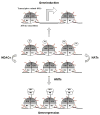Epigenetics and environmental chemicals
- PMID: 19663042
- PMCID: PMC3035853
- DOI: 10.1097/mop.0b013e32832925cc
Epigenetics and environmental chemicals
Abstract
Purpose of review: Epigenetics investigates heritable changes in gene expression occurring without changes in DNA sequence. Several epigenetic mechanisms, including DNA methylation, histone modifications, and microRNA expression, can change genome function under exogenous influence. Here, we review current evidence indicating that epigenetic alterations mediate toxicity from environmental chemicals.
Recent findings: In-vitro, animal, and human investigations have identified several classes of environmental chemicals that modify epigenetic marks, including metals (cadmium, arsenic, nickel, chromium, and methylmercury), peroxisome proliferators (trichloroethylene, dichloroacetic acid, and TCA), air pollutants (particulate matter, black carbon, and benzene), and endocrine-disrupting/reproductive toxicants (diethylstilbestrol, bisphenol A, persistent organic pollutants, and dioxin). Most studies conducted so far have been centered on DNA methylation, whereas only a few investigations have studied environmental chemicals in relation to histone modifications and microRNA.
Summary: For several exposures, it has been proved that chemicals can alter epigenetic marks, and that the same or similar epigenetic alterations can be found in patients with the disease of concern or in diseased tissues. Future prospective investigations are needed to determine whether exposed individuals develop epigenetic alterations over time and, in turn, which such alterations increase the risk of disease. Also, further research is needed to determine whether environmental epigenetic changes are transmitted transgenerationally.
Figures



References
Publication types
MeSH terms
Substances
Grants and funding
LinkOut - more resources
Full Text Sources
Research Materials

